Unit10I’d like some noodles.SectionAGrammarSectionBSelfCheck课件2023-2024学年度人教版英语七年级下册
文档属性
| 名称 | Unit10I’d like some noodles.SectionAGrammarSectionBSelfCheck课件2023-2024学年度人教版英语七年级下册 | 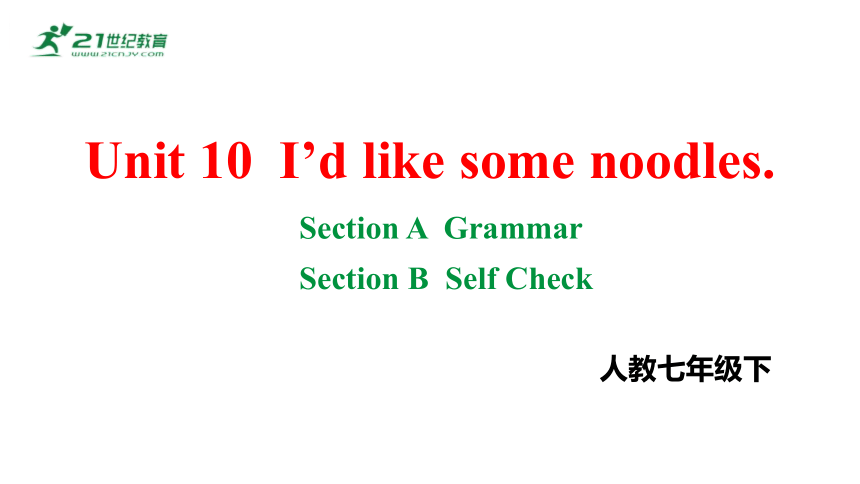 | |
| 格式 | pptx | ||
| 文件大小 | 59.3MB | ||
| 资源类型 | 试卷 | ||
| 版本资源 | 人教新目标(Go for it)版 | ||
| 科目 | 英语 | ||
| 更新时间 | 2024-04-26 15:10:35 | ||
图片预览



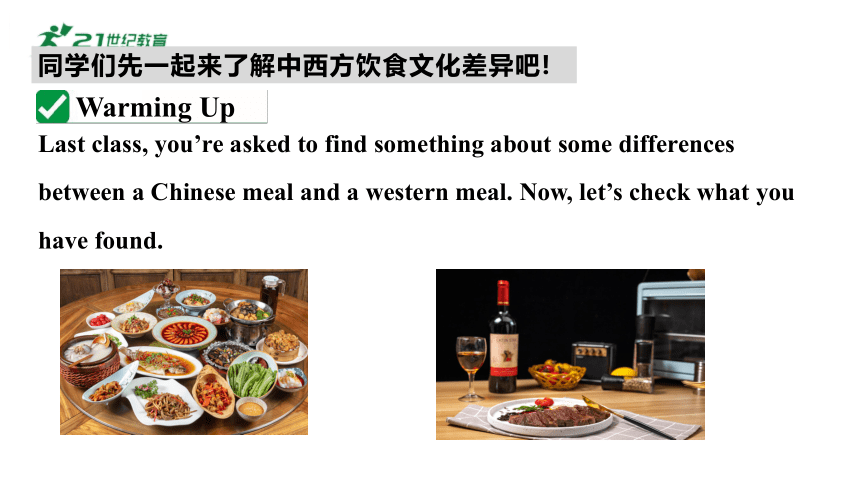
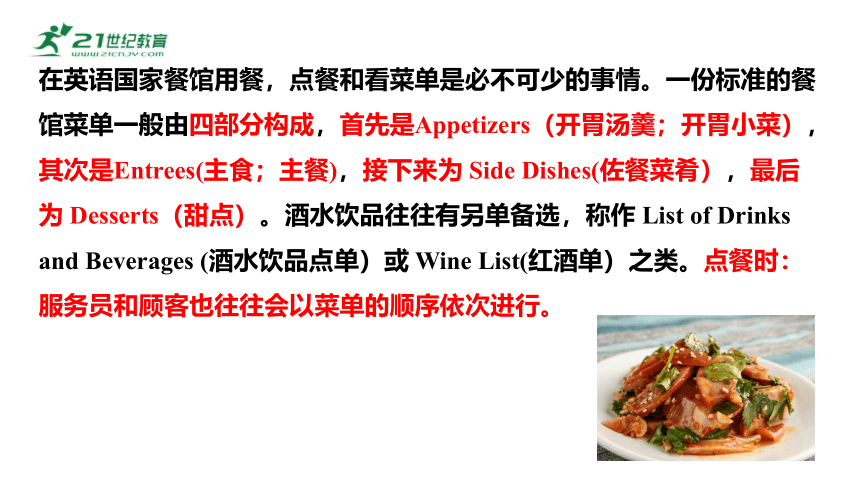
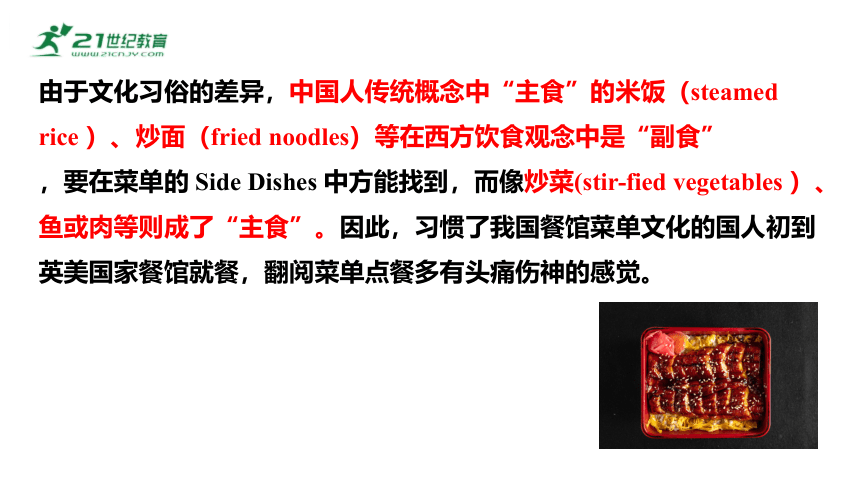
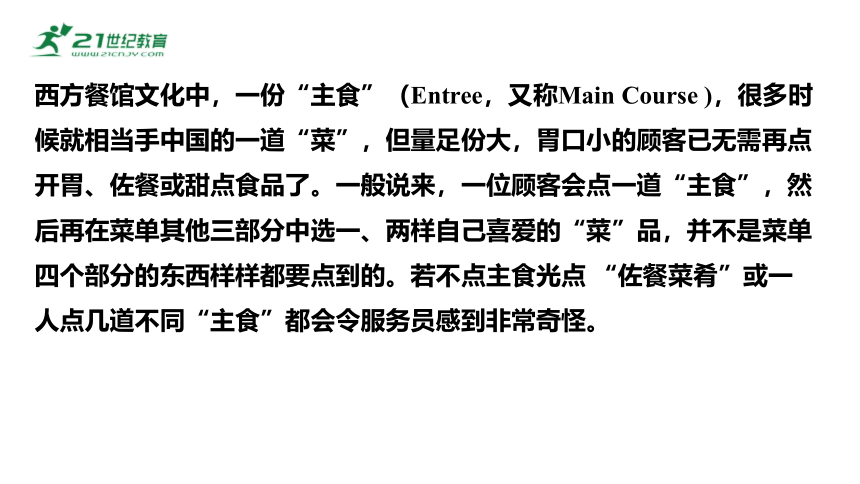
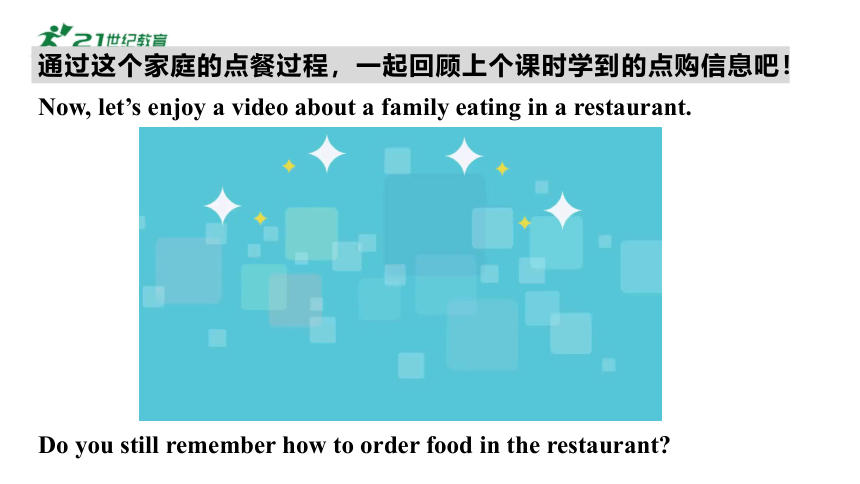

文档简介
(共28张PPT)
Unit 10 I’d like some noodles.
人教七年级下
Section A Grammar
Section B Self Check
为了更好地在实际生活中就餐饮进行交际,了解中西方餐饮文化习俗的差异,运用丰富的点餐方式进行沟通联系,增进情感,构建和谐人际关系。
核心任务
通过本课的学习,学生能够:
①能正确使用would like
②不定代词some和any
③能分辨并能正确使用可数名词和不可数名词
④积极地在运用所学知识进行交际。
Learning Goals
Last class, you’re asked to find something about some differences between a Chinese meal and a western meal. Now, let’s check what you have found.
Warming Up
同学们先一起来了解中西方饮食文化差异吧!
在英语国家餐馆用餐,点餐和看菜单是必不可少的事情。一份标准的餐馆菜单一般由四部分构成,首先是Appetizers(开胃汤羹;开胃小菜),其次是Entrees(主食;主餐),接下来为 Side Dishes(佐餐菜肴),最后为 Desserts(甜点)。酒水饮品往往有另单备选,称作 List of Drinks and Beverages (酒水饮品点单)或 Wine List(红酒单)之类。点餐时:
服务员和顾客也往往会以菜单的顺序依次进行。
由于文化习俗的差异,中国人传统概念中“主食”的米饭(steamed rice )、炒面(fried noodles)等在西方饮食观念中是“副食”
,要在菜单的 Side Dishes 中方能找到,而像炒菜(stir-fied vegetables )、鱼或肉等则成了“主食”。因此,习惯了我国餐馆菜单文化的国人初到英美国家餐馆就餐,翻阅菜单点餐多有头痛伤神的感觉。
西方餐馆文化中,一份“主食”(Entree,又称Main Course ),很多时候就相当手中国的一道“菜”,但量足份大,胃口小的顾客已无需再点开胃、佐餐或甜点食品了。一般说来,一位顾客会点一道“主食”,然后再在菜单其他三部分中选一、两样自己喜爱的“菜”品,并不是菜单四个部分的东西样样都要点到的。若不点主食光点 “佐餐菜肴”或一人点几道不同“主食”都会令服务员感到非常奇怪。
Now, let’s enjoy a video about a family eating in a restaurant.
Do you still remember how to order food in the restaurant
通过这个家庭的点餐过程,一起回顾上个课时学到的点购信息吧!
Look at the sentences below and the chart on your textbook. Can you try to summarize the sentence structure of would like
I’d like a bowl of mutton soup, please.
I’d like a cup of tea, please.
We’d like gongbao chicken and mapo tofu.
A: Would you like a sandwich B: Yes, please.
A: Would you like some coffee B:No, thanks.
Grammar
句式 肯定句 一般疑问句 特殊疑问句
结构
例句
回答
I’d like+ sth.
Would you like+ sth
疑问词+ would you
like + sth.
I’d like beef noodles.
We’d like gongbao chicken and mapo tofu.
Would you like a largr bowl
What kind of noodles would you like
What size would you like
Yes, please.
No, thanks.
I’d like beef noodles, please.
I’d like a medium bowl,please.
would like 在用法上与情态动词一样,没有人称变化,各种句式变化直接由would的变化来体现,不需要借助其他助动词。
I’d 是I would的缩写;we’d 是we would的缩写。
Look at the sentences below and answer the questions.
Would you like some coffee
There’s some milk in the fridge.
There are some eggs in the fridge.
There are some tomatoes in the beef soup.
There isn’t any milk in the fridge.
We don’t have any shirts in your size.
Is there any news from Harry
1.some/any 通常用在什么句式中?表达什么含义?
2.some/any 通常可以用来修饰或限定什么词?
some/any 通常可接可数名词和不可数名词,表示不确定的数量。
some常译作 “一些”,多用于肯定句,也可用于疑问句表示希望得到对方的肯定答复,以示礼貌。
any表示“任何”,多用于否定句和疑问句中。
Look at the chart on your textbook. Summarize 【C】and 【UC】nouns
Countable nouns Uncountable nouns Countable and
uncountable nouns
bowls, apples, carrots, oranges, strawberries beef, meat, milk, mutton, water chicken, salad, ice-cream,
cabbage, cake
①可数名词有复数形式,大多数水果、蔬菜属于可数名词;
②不可数名词没有复数形式,主食、肉类、饮料多属于不可数名词;
③还有少数名词既可能是可数名词也可能是不可数名词,但词义不同,如chicken,作“鸡肉”讲时是不可数名词,作“小鸡”讲时是可数名词。
可数名词 不可数名词
有单数和复数之分。 如:an apple、two apples。
(1) 其前可直接用不定冠词a/an或具体的基数词修饰,表示数量。 如:a boy、an apple、two potatoes。 (2) 可用定冠词the修饰,表示特指,如:the girl(这个女孩)。
可用some、any、few、a few、many、 lots of、a lot of等修饰。
询问数量多少用how many。
没有复数形式。
如:beef, mutton, meat, milk。
(1) 其前不能用不定冠词a/an或
直接用基数词修饰。
(2) 可用定冠词the修饰,表示特指
,如:the bread(这块面包)。
可用some、any、little、a little、much、a lot of、lots of等修饰。
询问量的多少用how much。
不可数名词的量可以用 “a/an/基数词+量词 + of + 不可数名词” 表示,这些量词有单复数形式的变化。这一结构作主语时,谓语动词的单复数形式要与表示量的名词保持一致。
There is a bottle of orange juice on the table.
桌子上有一瓶橙子汁。(谓语动词is与a bottle保持一致)
There are three bowls of mutton soup on the table.
桌子上有三碗羊肉汤。(谓语动词are与three bowls保持一致)
3a
1. May I have your order
2. What kind of noodles would you like
3. We have beef, chicken, mutton, cabbage, potato, tomato...
4. Yes, there are some carrots.
5. Sure. What size would you like
6. We have large, medium and small bowls.
d. I’d like some noodles, please.
a. What kind of noodles do you have
f. Are there any vegetables in the mutton noodles
c.OK, I’d like the mutton noodles then.
e. What sizes do you have
d. Oh, a medium bowl, please.
想象自己身处一个中餐馆,和服务员交流,点购自己喜欢的食物:
1._________________________________________
_________________________________________
2._________________________________________ (size)
_____________________________________(medium)
3.__________________________________ (any/cabbage/beef noodles)
___________________ (no)
3b Write questions and answers using the words in brackets.
(chicken/beef/tomatoes)
What kind of noodles would you like (kind)
I’d like chicken and beef noodles with tomatoes.
What size would you like
I’d like a medium bowl, please.
Is there any cabbage in the beef noodles
No, there isn’t any.
3c Work in small groups. Who would like the food below Write their names on the cards above the food.
A: Anna, what would you like to eat
B: I’d like beef noodles with carrots.
同学们多多参与,相互交流自己喜欢的食物和常用的点餐方式:
Now, show your reports to all of us.
In our group, Sally and Tom would like some hamburgers. Anna and Jim would like tomato and egg rice. Nobody would like potato salad.
1 Put the words you learned in different groups.
Food Drink Other
Meat Vegetable Fruit cake
beef
chicken
mutton
cabbage
carrot
tomato
onion
orange
strawberry
apple
banana
milk
orange juice
water
pancake
dumplings
porridge
Self Check
一起来总结大家喜欢点购的食物吧!
2 Complete the sentences with the correct forms of the there be structure.
1. Customer: Excuse me, _______ _____ a fly (苍蝇) in my porridge.
Waiter: Don’t worry (别急), sir. That spider (蜘蛛) on your bread will soon get him.
2. Customer: _______ _____ two flies in my fish soup.
Waiter: I know. But we are short of fish.
3. Customer: We ordered mutton noodles, but _______ _____ any mutton in the noodles.
Waiter: Put on your glasses and you can see the mutton.
there is
There are
there isn’t
一起来总结一些餐馆可能会有的意外情况吧!
3 Write a conversation with the help of the clues.
In a restaurant:
Waiter: Ask for the order
Customer: Ask about what is in the food
Customer: Thank the waiter
Waiter: Ask for the size of the order
一起来总结餐馆常用的点购流程吧!
Waiter: What would you like
Customer: Let me think about it. Are there any vegetables in the beef noodles
Waiter: Yes, there are some carrots and tomatoes.
Customer: OK. I’ll have the beef noodles.
Waiter: What size would you like
Customer: I’ll just have a small bowl, please.
Waiter: OK. So that’s one small bowl of beef noodles.
Customer: Thank you.
l. Most of my friends like eating______(面包).
2. Mom likes to buy some______ (牛奶) for breakfast.
3. For soup, I like two __________(番茄) and an______ (鸡蛋) soup best.
4. My little brother can eat a bowl of _________!(羊肉).
5.—Here is some___________ (鸡肉) for my dad.
bread
milk
tomatoes
egg
mutton
chicken
Exercises
同学们互相分享自己朋友或亲人的饮食喜好。
7. My friend Bob never eats________ (牛肉).
8. Many Chinese families like to eat___________ (饺子).
beef
dumplings
1. She would like a large bowl.(对画线部分提问)
___________bowl would she like
What size
2. There is an egg and a tomato in the soup.(改为一般疑问句)
_________an egg and a tomato in the soup
3. I’d like beef noodles.(对画线部分提问)
_____________noodles would you like
4.I’d like chicken soup with rice.(改为一般疑问句)
___________like chicken soup with rice
5. We’d like one bowl of beef soup.(对画线部分提问)
____________you like
Is there
What kind of
Would you
What would
想象自己是服务人员,提问顾客,确定点单内容。
Grammar:
①能正确使用would like
②不定代词some和any
③能分辨并能正确使用可数名词和不可数名词
Summary
Write at least ten countable nouns, ten uncountable nouns on your notebook. The words we learnt in this unit should be excluded(排除).
实践与拓展
Unit 10 I’d like some noodles.
人教七年级下
Section A Grammar
Section B Self Check
为了更好地在实际生活中就餐饮进行交际,了解中西方餐饮文化习俗的差异,运用丰富的点餐方式进行沟通联系,增进情感,构建和谐人际关系。
核心任务
通过本课的学习,学生能够:
①能正确使用would like
②不定代词some和any
③能分辨并能正确使用可数名词和不可数名词
④积极地在运用所学知识进行交际。
Learning Goals
Last class, you’re asked to find something about some differences between a Chinese meal and a western meal. Now, let’s check what you have found.
Warming Up
同学们先一起来了解中西方饮食文化差异吧!
在英语国家餐馆用餐,点餐和看菜单是必不可少的事情。一份标准的餐馆菜单一般由四部分构成,首先是Appetizers(开胃汤羹;开胃小菜),其次是Entrees(主食;主餐),接下来为 Side Dishes(佐餐菜肴),最后为 Desserts(甜点)。酒水饮品往往有另单备选,称作 List of Drinks and Beverages (酒水饮品点单)或 Wine List(红酒单)之类。点餐时:
服务员和顾客也往往会以菜单的顺序依次进行。
由于文化习俗的差异,中国人传统概念中“主食”的米饭(steamed rice )、炒面(fried noodles)等在西方饮食观念中是“副食”
,要在菜单的 Side Dishes 中方能找到,而像炒菜(stir-fied vegetables )、鱼或肉等则成了“主食”。因此,习惯了我国餐馆菜单文化的国人初到英美国家餐馆就餐,翻阅菜单点餐多有头痛伤神的感觉。
西方餐馆文化中,一份“主食”(Entree,又称Main Course ),很多时候就相当手中国的一道“菜”,但量足份大,胃口小的顾客已无需再点开胃、佐餐或甜点食品了。一般说来,一位顾客会点一道“主食”,然后再在菜单其他三部分中选一、两样自己喜爱的“菜”品,并不是菜单四个部分的东西样样都要点到的。若不点主食光点 “佐餐菜肴”或一人点几道不同“主食”都会令服务员感到非常奇怪。
Now, let’s enjoy a video about a family eating in a restaurant.
Do you still remember how to order food in the restaurant
通过这个家庭的点餐过程,一起回顾上个课时学到的点购信息吧!
Look at the sentences below and the chart on your textbook. Can you try to summarize the sentence structure of would like
I’d like a bowl of mutton soup, please.
I’d like a cup of tea, please.
We’d like gongbao chicken and mapo tofu.
A: Would you like a sandwich B: Yes, please.
A: Would you like some coffee B:No, thanks.
Grammar
句式 肯定句 一般疑问句 特殊疑问句
结构
例句
回答
I’d like+ sth.
Would you like+ sth
疑问词+ would you
like + sth.
I’d like beef noodles.
We’d like gongbao chicken and mapo tofu.
Would you like a largr bowl
What kind of noodles would you like
What size would you like
Yes, please.
No, thanks.
I’d like beef noodles, please.
I’d like a medium bowl,please.
would like 在用法上与情态动词一样,没有人称变化,各种句式变化直接由would的变化来体现,不需要借助其他助动词。
I’d 是I would的缩写;we’d 是we would的缩写。
Look at the sentences below and answer the questions.
Would you like some coffee
There’s some milk in the fridge.
There are some eggs in the fridge.
There are some tomatoes in the beef soup.
There isn’t any milk in the fridge.
We don’t have any shirts in your size.
Is there any news from Harry
1.some/any 通常用在什么句式中?表达什么含义?
2.some/any 通常可以用来修饰或限定什么词?
some/any 通常可接可数名词和不可数名词,表示不确定的数量。
some常译作 “一些”,多用于肯定句,也可用于疑问句表示希望得到对方的肯定答复,以示礼貌。
any表示“任何”,多用于否定句和疑问句中。
Look at the chart on your textbook. Summarize 【C】and 【UC】nouns
Countable nouns Uncountable nouns Countable and
uncountable nouns
bowls, apples, carrots, oranges, strawberries beef, meat, milk, mutton, water chicken, salad, ice-cream,
cabbage, cake
①可数名词有复数形式,大多数水果、蔬菜属于可数名词;
②不可数名词没有复数形式,主食、肉类、饮料多属于不可数名词;
③还有少数名词既可能是可数名词也可能是不可数名词,但词义不同,如chicken,作“鸡肉”讲时是不可数名词,作“小鸡”讲时是可数名词。
可数名词 不可数名词
有单数和复数之分。 如:an apple、two apples。
(1) 其前可直接用不定冠词a/an或具体的基数词修饰,表示数量。 如:a boy、an apple、two potatoes。 (2) 可用定冠词the修饰,表示特指,如:the girl(这个女孩)。
可用some、any、few、a few、many、 lots of、a lot of等修饰。
询问数量多少用how many。
没有复数形式。
如:beef, mutton, meat, milk。
(1) 其前不能用不定冠词a/an或
直接用基数词修饰。
(2) 可用定冠词the修饰,表示特指
,如:the bread(这块面包)。
可用some、any、little、a little、much、a lot of、lots of等修饰。
询问量的多少用how much。
不可数名词的量可以用 “a/an/基数词+量词 + of + 不可数名词” 表示,这些量词有单复数形式的变化。这一结构作主语时,谓语动词的单复数形式要与表示量的名词保持一致。
There is a bottle of orange juice on the table.
桌子上有一瓶橙子汁。(谓语动词is与a bottle保持一致)
There are three bowls of mutton soup on the table.
桌子上有三碗羊肉汤。(谓语动词are与three bowls保持一致)
3a
1. May I have your order
2. What kind of noodles would you like
3. We have beef, chicken, mutton, cabbage, potato, tomato...
4. Yes, there are some carrots.
5. Sure. What size would you like
6. We have large, medium and small bowls.
d. I’d like some noodles, please.
a. What kind of noodles do you have
f. Are there any vegetables in the mutton noodles
c.OK, I’d like the mutton noodles then.
e. What sizes do you have
d. Oh, a medium bowl, please.
想象自己身处一个中餐馆,和服务员交流,点购自己喜欢的食物:
1._________________________________________
_________________________________________
2._________________________________________ (size)
_____________________________________(medium)
3.__________________________________ (any/cabbage/beef noodles)
___________________ (no)
3b Write questions and answers using the words in brackets.
(chicken/beef/tomatoes)
What kind of noodles would you like (kind)
I’d like chicken and beef noodles with tomatoes.
What size would you like
I’d like a medium bowl, please.
Is there any cabbage in the beef noodles
No, there isn’t any.
3c Work in small groups. Who would like the food below Write their names on the cards above the food.
A: Anna, what would you like to eat
B: I’d like beef noodles with carrots.
同学们多多参与,相互交流自己喜欢的食物和常用的点餐方式:
Now, show your reports to all of us.
In our group, Sally and Tom would like some hamburgers. Anna and Jim would like tomato and egg rice. Nobody would like potato salad.
1 Put the words you learned in different groups.
Food Drink Other
Meat Vegetable Fruit cake
beef
chicken
mutton
cabbage
carrot
tomato
onion
orange
strawberry
apple
banana
milk
orange juice
water
pancake
dumplings
porridge
Self Check
一起来总结大家喜欢点购的食物吧!
2 Complete the sentences with the correct forms of the there be structure.
1. Customer: Excuse me, _______ _____ a fly (苍蝇) in my porridge.
Waiter: Don’t worry (别急), sir. That spider (蜘蛛) on your bread will soon get him.
2. Customer: _______ _____ two flies in my fish soup.
Waiter: I know. But we are short of fish.
3. Customer: We ordered mutton noodles, but _______ _____ any mutton in the noodles.
Waiter: Put on your glasses and you can see the mutton.
there is
There are
there isn’t
一起来总结一些餐馆可能会有的意外情况吧!
3 Write a conversation with the help of the clues.
In a restaurant:
Waiter: Ask for the order
Customer: Ask about what is in the food
Customer: Thank the waiter
Waiter: Ask for the size of the order
一起来总结餐馆常用的点购流程吧!
Waiter: What would you like
Customer: Let me think about it. Are there any vegetables in the beef noodles
Waiter: Yes, there are some carrots and tomatoes.
Customer: OK. I’ll have the beef noodles.
Waiter: What size would you like
Customer: I’ll just have a small bowl, please.
Waiter: OK. So that’s one small bowl of beef noodles.
Customer: Thank you.
l. Most of my friends like eating______(面包).
2. Mom likes to buy some______ (牛奶) for breakfast.
3. For soup, I like two __________(番茄) and an______ (鸡蛋) soup best.
4. My little brother can eat a bowl of _________!(羊肉).
5.—Here is some___________ (鸡肉) for my dad.
bread
milk
tomatoes
egg
mutton
chicken
Exercises
同学们互相分享自己朋友或亲人的饮食喜好。
7. My friend Bob never eats________ (牛肉).
8. Many Chinese families like to eat___________ (饺子).
beef
dumplings
1. She would like a large bowl.(对画线部分提问)
___________bowl would she like
What size
2. There is an egg and a tomato in the soup.(改为一般疑问句)
_________an egg and a tomato in the soup
3. I’d like beef noodles.(对画线部分提问)
_____________noodles would you like
4.I’d like chicken soup with rice.(改为一般疑问句)
___________like chicken soup with rice
5. We’d like one bowl of beef soup.(对画线部分提问)
____________you like
Is there
What kind of
Would you
What would
想象自己是服务人员,提问顾客,确定点单内容。
Grammar:
①能正确使用would like
②不定代词some和any
③能分辨并能正确使用可数名词和不可数名词
Summary
Write at least ten countable nouns, ten uncountable nouns on your notebook. The words we learnt in this unit should be excluded(排除).
实践与拓展
同课章节目录
- Unit 1 Can you play the guitar?
- Section A
- Section B
- Unit 2 What time do you go to school?
- Section A
- Section B
- Unit 3 How do you get to school?
- Section A
- Section B
- Unit 4 Don't eat in class.
- Section A
- Section B
- Unit 5 Why do you like pandas?
- Section A
- Section B
- Unit 6 I'm watching TV.
- Section A
- Section B
- Review of Units 1-6
- Unit 7 It's raining!
- Section A
- Section B
- Unit 8 Is there a post office near here?
- Section A
- Section B
- Unit 9 What does he look like?
- Section A
- Section B
- Unit 10 I'd like some noodles.
- Section A
- Section B
- Unit 11 How was your school trip?
- Section A
- Section B
- Unit 12 What did you do last weekend?
- Section A
- Section B
